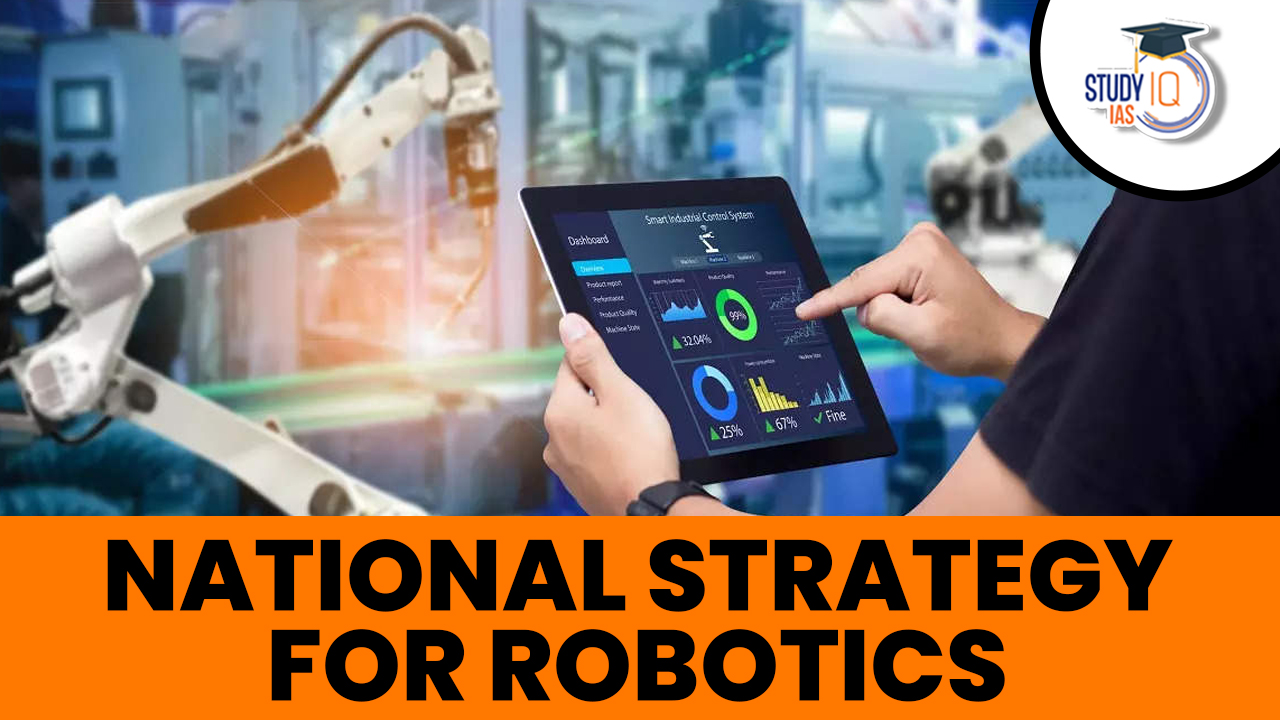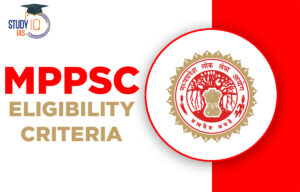Table of Contents
Context: The Ministry of Electronics and Information Technology (MeitY) has invited public comments as well as inputs from stakeholders on the draft “National Strategy for Robotics” (NSR).
More on the News
- The draft National Strategy for Robotics (NSR) proposes a policy framework for the implementation of robotics in various sectors, with the aim of making India a global robotics leader by 2030.
- It also builds upon the mandates of the Make in India 2.0 plans, which identify robotics as one of the 27 sub-sectors to further enhance India’s integration in the global value chain.
Major highlights of the draft National Strategy for Robotics (NSR)
What is Robotics?
- The Bureau of Indian Standards (BIS) defines Robotics as the science and practice of designing, manufacturing, and applying robots.
- A robot operates by sensing its environment, carrying out computations for decision making, and performing actions.
- Recently, advances in artificial intelligence (AI) and machine learning have led to the development of more advanced robots that can perform tasks that were previously thought to be exclusive to humans, such as visual perception, speech recognition, and decision-making.
Types of Robots
The Scope of the National Strategy is limited to the classification of robots as per the Bureau of Indian Standard’s standards for robots, as detailed below:
- Industrial Robots: These are programmable machines with multiple moveable joints used in industrial settings for tasks like assembling, welding, and product inspection.
- Service Robots: Service robots are designed for personal or professional use and perform tasks like cleaning, transportation, and providing guidance. They are used in non-industrial environments such as homes, hospitals, and offices.
- Medical Robots: Medical robots are specialized for medical applications and are considered medical electrical equipment. They are used in healthcare settings for tasks related to surgery, diagnostics, and patient care.
Current Scenario of Robotics
Global Scenario
- According to the International Federation of Robotics (IFR) presently there are over 3 million industrial robots operating in factories around the world, with half a million installations added in 2021, representing a CAGR of 14% from 2016 to 2021.
- Asia remains the world’s largest market for industrial robots with 74% of all newly deployed robots in 2021 installed in Asia.
- One of the major factors driving the growth of industrial robots is the increasing adoption of Industry 4.0, which involves the integration of advanced technologies such as IoT, AI, and machine learning into industrial processes.
- According to the World Robotics Report 2022, the five major markets for industrial robots are China, Japan, the United States, the Republic of Korea, and Germany. These countries accounted for 78% of global robot installations.
- According to the International Federation of Robotics (IFR), the market for professional service robots grew to a turnover of $6.7 billion U.S. dollars globally– up 12% in 2020.
Indian Scenario
- Since 2016, the operational stock of industrial robots has more than doubled in India to reach 33,220 units in 2021, averaging at an annual growth rate of 16%.
- Presently, in terms of annual industrial installations, India ranks 10th globally as per the World Robotics Report, 2022.
- The long-term potential of robotics in India is significant as a catalyst for revolutionizing industries, driving inclusive growth and improving the standard of living.
- However, despite its potential, the growth of the robotics ecosystem in India has been slower in comparison to certain developed economies.
Focus Areas for Robotic Automation in India
The National Strategy on Robotics has identified four priority sectors with the maximum potential for robotics adoption and to position India as a global leader in robotics across these sectors by 2030:
| Sector | Potential for Automation | AI Penetration |
| Manufacturing | Robotic technology can be leveraged for several use cases including:
|
|
| Healthcare | Robotic technology can be leveraged for several use cases including:
|
|
| Agriculture | Robotic technology can be leveraged for several use cases including:
|
|
| National Security | Robotic technology can be leveraged for several use cases including:
|
|
Artificial Intelligence in the field of Robotics
Artificial Intelligence (AI) is playing a crucial role in advancing robotics. It enables robots to perform complex tasks and make autonomous decisions. Key aspects of AI in robotics include:
- Learning and Adaptation: AI allows robots to learn from large sets of data and improve their performance over time.
- For example, robots can be trained to recognize objects in their environment, enhancing tasks like grasping and navigation.
- Machine Learning: Machine learning algorithms can also be used to improve the control of robots such as using reinforcement learning to optimize the robot’s control policies.
- Also, deep learning techniques such as convolutional neural networks can be used for image processing, such as object detection and semantic segmentation.
- Commercial Use Cases: AI in robotics is applied in two main areas:
- Sense-and-response applications: Real-time robots use sensors and AI algorithms to detect their surroundings and make decisions. This includes tasks like object manipulation and navigation.
- Performance optimization: AI is used offline to analyze data from robots, leading to improvements in process design, programming, maintenance, and quality inspection.
Other Emerging Technologies in the Field of Robotics
As robotics evolves, it converges with other technologies:
- Autonomous Systems: Robots and drones can operate without human intervention, improving efficiency and safety in various industries.
- Internet of Things (IoT): Integrating IoT technology with robots enables real-time data collection and better decision-making, enhancing user experience.
- Human-Robot Collaboration (Cobots): Robots designed to work safely alongside humans are crucial in manufacturing and healthcare.
- 5G and Edge Computing: The implementation of 5G networks and edge computing enables faster data transfer and real-time control and monitoring of robots.
- Additive Manufacturing (3D Printing): 3D printing accelerates product design and is critical for soft robotics, allowing the creation of adaptable robots for complex environments.
National Efforts
Several initiatives have been taken in the recent past to catalyse the robotics ecosystem in India.
| Research & Development Centres |
|
| Capacity Building Initiatives |
|
| Make-in-India Robots |
|
Current Challenges in the Indian Robotics Ecosystem
- Inadequate Skilled Human Resources: Shortage of technically proficient engineers and technicians, especially in maintenance and servicing, hinders the development and growth of robotics in India.
- Heavy Reliance on Imports: India heavily relies on imports for critical components and subsystems of robots, limiting the domestic supply chain and adding to the cost.
- High Costs: Customization of robots for specific needs and environments, coupled with complex maintenance and service requirements, makes robotics adoption expensive, particularly for small and medium-sized enterprises (SMEs).
- Technological Limitations: Foundational research in core robotic technologies is in the early stages in India, and access to advanced manufacturing facilities for prototyping and testing is limited.
- Absence of Multidisciplinary Collaboration: Robotics increasingly integrates with other technologies, requiring multidisciplinary collaboration, which is currently lacking in the ecosystem.
- Lack of Awareness: Limited understanding of robotics and its potential benefits results in misconceptions and reluctance to invest in research and deployment, especially among SMEs.
- Limited Governance Mechanisms: Lack of specific legislation for robotics and allied technologies, as well as inadequate technical standards and certifications, hampers innovation and deployment.
- Lack of Reliable Infrastructure: Inconsistent energy supply and unreliable internet connectivity in some areas hinder the continuous and efficient operation of robots.
- Ethical Considerations: Addressing ethical concerns related to employment, transparency in autonomous decision-making, and privacy and security is crucial to building public trust in robotics.
Strategic Recommendations
- Enhancing Research and Development (R&D):
- Improve the availability of funding for robotics research.
- Promote collaborative efforts with Centers of Excellence (CoEs) for AI and Cyber-Physical Systems.
- Establish platforms for global partnerships in research.
- Attract and retain skilled professionals in the field.
- Fund Moonshot Projects for groundbreaking research and innovation in robotics.
- Demonstration and Testing:
- Develop infrastructure and demonstration facilities for testing, validation, and certification of robots.
- Ensure responsible and safe adoption of robotics technology.
- Commercialization and Supply Chain Development:
- Implement fiscal and non-fiscal interventions to support robotics startups.
- Develop supporting infrastructure for the robotics industry.
- Implement policy measures to increase domestic value addition and promote exports.
- Adoption and Awareness:
- Promote the penetration and adoption of robots in India.
- Provide fiscal and non-fiscal support for market expansion.
- Create a regulatory framework for robotics.
- Conduct awareness campaigns to educate the public and industries about the benefits and responsible use of robotics.
- Improve access to network infrastructure to facilitate the deployment of robotic systems.
- Capacity Building:
- Focus on building capacities across the innovation lifecycle.
- Provide training and education in robotics and related fields to develop a skilled workforce.
- Ensure India has the talent and expertise needed to compete globally in the robotics market.
- Two-Tier Institutional Framework: Establish a two-tier institutional framework to facilitate the implementation of the National Strategy on Robotics, known as the ‘National Robotics Mission.’
- Alignment with India AI Vision: Ensure that the National Strategy on Robotics aligns with the broader India AI vision and supports the objectives of Cyber-Physical Systems.


 AIBE 21 Exam Date 2025: Check Official S...
AIBE 21 Exam Date 2025: Check Official S...
 JPSC Exam Calendar 2026 Released: Check ...
JPSC Exam Calendar 2026 Released: Check ...
 MPPSC Eligibility Criteria 2026, Age Lim...
MPPSC Eligibility Criteria 2026, Age Lim...

























